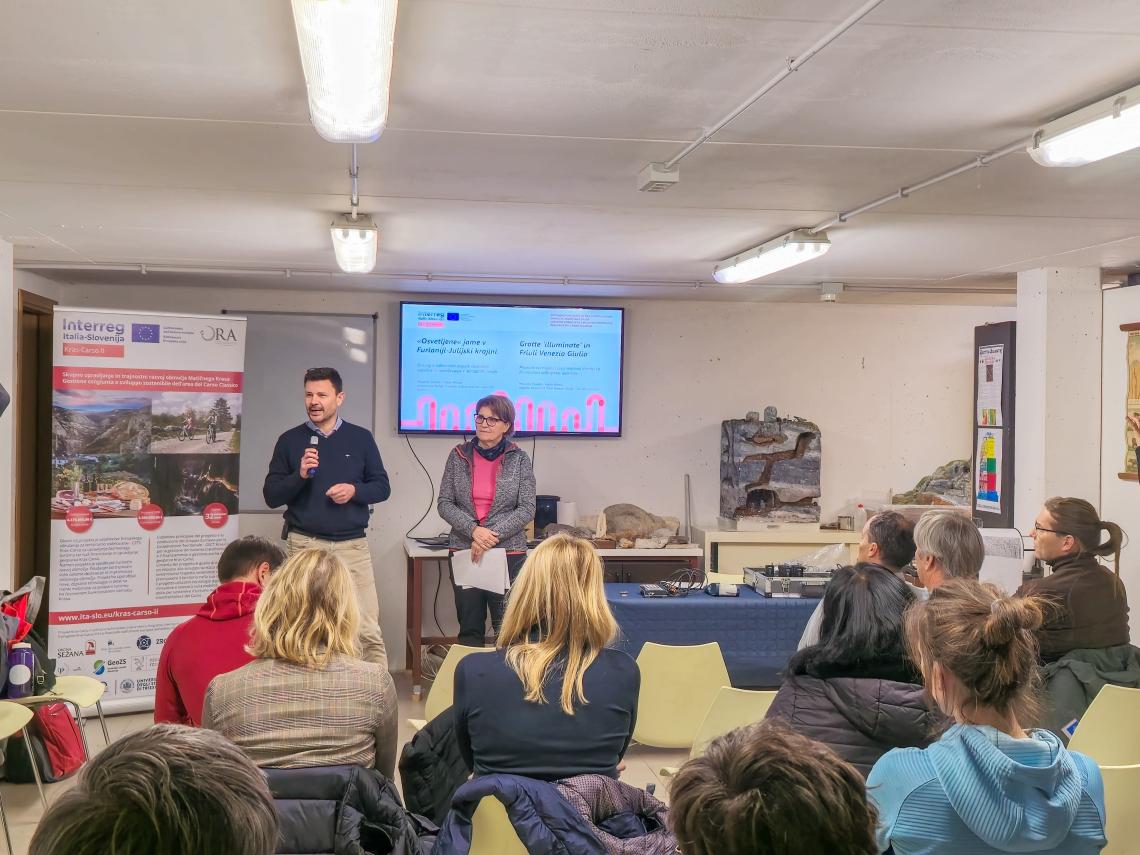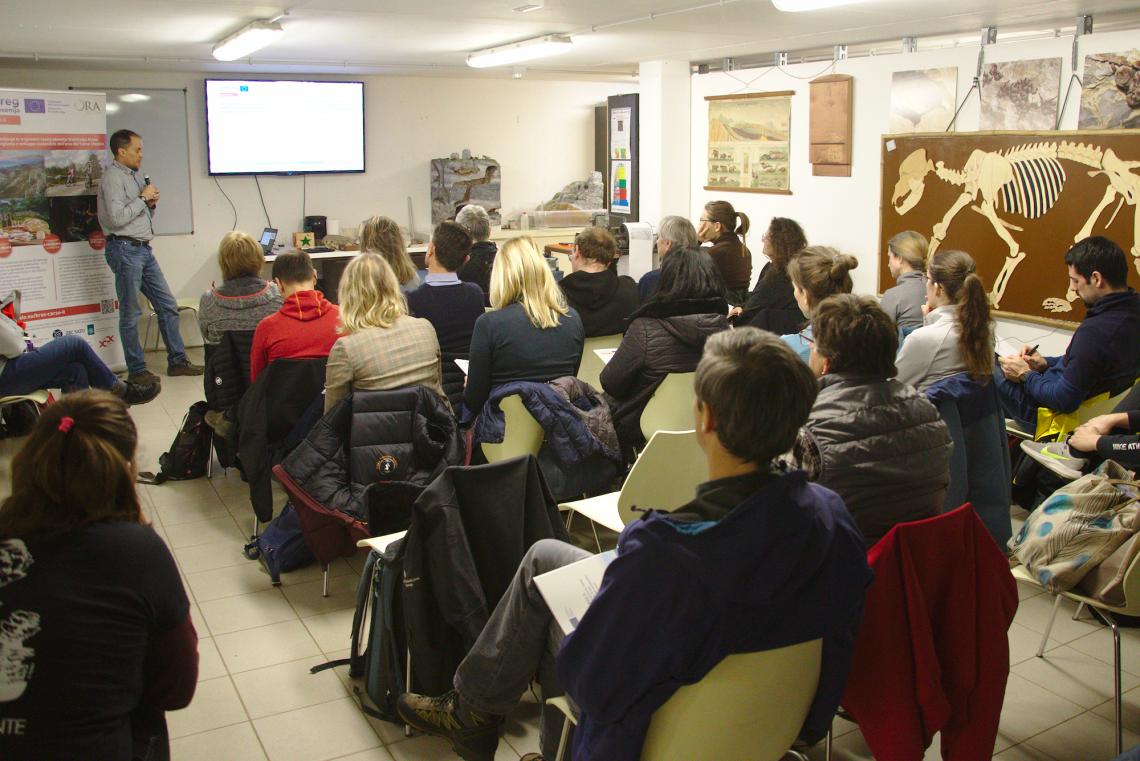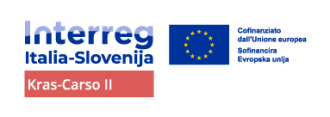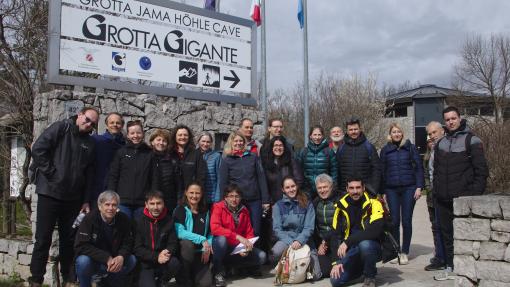As part of the KRAS-CARSO II project, co-financed by the European Union under the Interreg VI-A Italy-Slovenia Programme, a workshop for cave managers on the topic of lampenflore in caves was held on Monday 17 March 2025 in the Giant Cave (Briškovska jama) in Briščiki (Borgo Grotta Gigante). The event was organised by the Institute of the Republic of Slovenia for Nature Conservation (Zavod RS za varstvo narav) in cooperation with the project partners the Karst Research Institute (Inštitut za raziskovanje Krasa ZRC SAZU), Škocjan Caves Park (Park Škocjanske jame), Friuli Venezia Giulia Region, the lead partner ORA and the host of the workshop, Giant Cave (Briškovska jama). The event was held entirely in Slovene and Italian, with translations provided by the Office of the Slovene Language of the Autonomous Region of Friuli Venezia Giulia Region.
The term lampenflora refers to the phenomenon of mainly phototrophic organisms growing near artificial light sources in caves. Tourist caves that have electric lighting for sightseeing all have lampenflora as a consequence of the use of lamps in the cave. Lampenflora is a major challenge in terms of preserving the cave, the cave inventory and the underground living world, as well as a challenge for the operators, who are certainly not proud of the green growth in the cave.
The workshop was attended by operators and cavers from Divaška Cave (Gregor Žiberna Caving Society Divača), Dimnice (Dimnice Caving Society), Vilenica (Sežana Caving Society), Škocjan Caves, San Giovanni d'Antro Cave (Landarske jame), Slivia Towers Cave (Pejce v Lascu) and Giant Cave (Briškovska jama). The good response of the cave operators is a sign of mutual cross-border cooperation, of the desire for a unified management of the caves on both sides of the border of the Kras-Carso Geopark in the making, and of the priority of many cave operators to preserve the caves and a healthy cave environment in the long term.
The workshop participants were first welcomed by Martina Stupar from the Institute of the RS for Nature Conservation (Zavod RS za varstvo narav), Aldo Fedel, Director of the Giant Cave (Briškovska jama), and Massimo Zanetti, Director of the Geological Survey of Friuli Venezia Giulia (del Servizio geologico della Regione Friuli Venezia Giulia), who, in collaboration with Paolo Manca, presented the international guidelines for cave conservation of the UIS, IUCN and their application to cave illumination in Friuli Venezia Giulia. The participants then listened to an expert lecture on lampenflora as a challenge for tourist caves by Dr. Janez Mulc from the Institute for Karst Research of the Slovenian Karst Research Centre (Inštitut za raziskovanje Krasa ZRC SAZU). The presentation included a basic explanation of the topic, the causes, the consequences for the natural environment in caves and a set of the most common measures to prevent and remove lampenflora. The aspects of tourist cave management with regard to the problem of limiting the growth of lampenflora were presented by Samo Šturm, using the example of Škocjan Caves. He presented technical and mitigation measures, such as reducing the illumination time, sectoral illumination and reducing the lamp power. He also stressed the importance of regular monitoring and measurement of the cave situation and of taking regular and ongoing measures as soon as lampenflora appears in the cave. Dr. Mulec then presented the status and examples of lampenflora in the Giant Cave (Briškovska jama), which was later demonstrated in the field.The lectures and presentations were followed by a discussion with questions and comments on the physical removal of vegetation and the lighting of the cave. Participants were interested in the optimum time for cave lighting, the power and type of lamps, the frequency of lamp monitoring, the impact of CO2, innovative solutions and technological advances in lampenflore prevention.
The afternoon part of the workshop took place in the Giant Cave (Briškovska jama). At a selected location in the cave, experts Dr. Janez Mulec and Samo Šturm demonstrated how to carry out light, illumination and temperature measurements. They pointed out the different types of vegetation at selected locations in the cave according to distance, temperature, presence of moisture and water on the substrate, exposure time and light intensity. The group was guided through the cave by Federica Papi, a local guide, who gave a presentation on the characteristics and conditions of the cave and its management.
The feedback from the participants during and after the workshop was very positive; the cave operators gained a lot of knowledge and the opportunity to work with professional services that they can turn to in case of any challenges in cave management. The event was also attended by a journalist from RTV Koper, which shows the increasing visibility of the project and the future Kras-Carso Geopark in the wider public.



